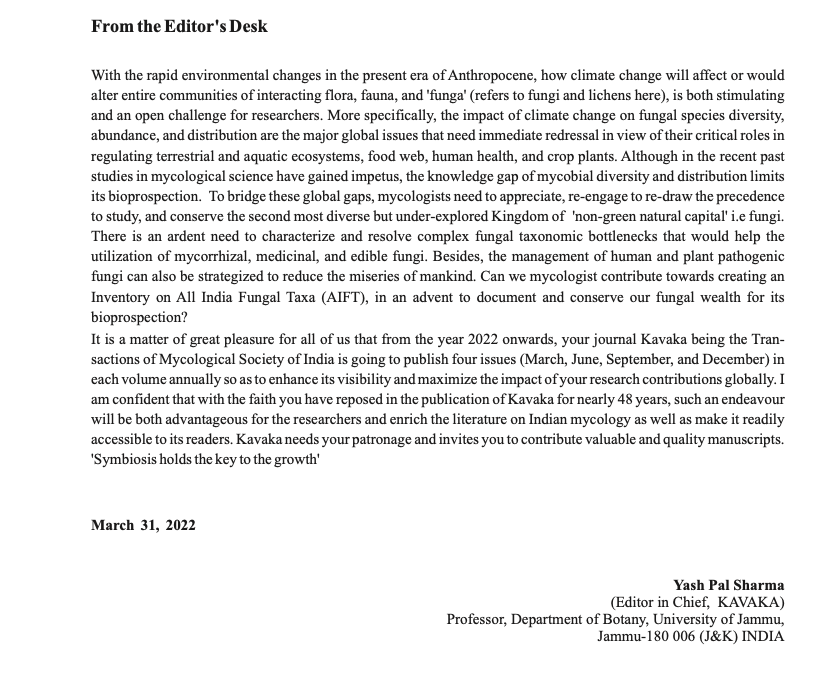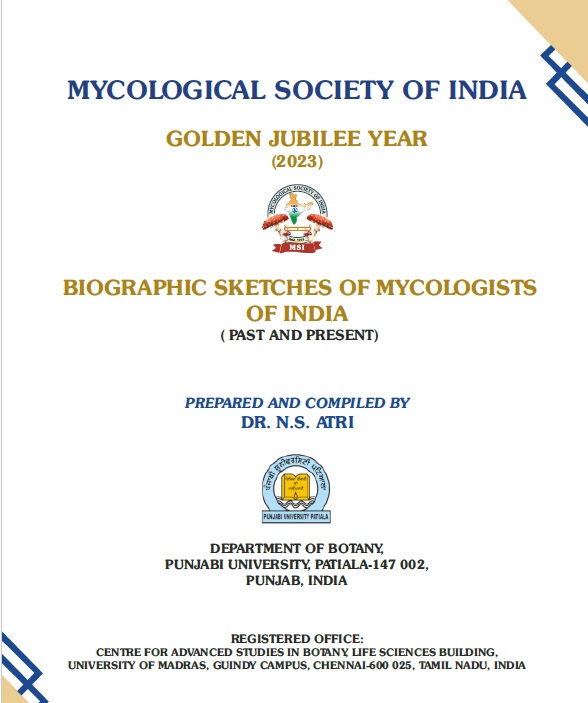
KAVAKA 58 (1): 1-4 (2022) doi:10.36460/Kavaka/58/1/2022/1-4
New records of Crepidotus (Crepidotaceae) from Kerala, India
Manoj Kumar1 and C.K. Pradeep2*
1Post Graduate and Research Department of Botany, Government College for Women, Thiruvananthapuram, 695 014, Kerala, India.
2Microbiology Division, Jawaharlal Nehru Tropical Botanic Garden & Research Institute, Palode, Thiruvananthapuram, 695 562, Kerala, India.
*Corresponding author Email: This email address is being protected from spambots. You need JavaScript enabled to view it.
(Submitted on January 12, 2022; Accepted on March 02, 2022)
ABSTRACT
During an ongoing inventory study on the crepidotoid agarics of Kerala State, two interesting Crepidotus were encountered and identified by morphotaxonomic procedure. Of the two, Crepidotus latifolius forms a new record to India while C. mollis is reporting for the first time from Kerala. Complete descriptions, photographs and comparisons with related taxa are provided.
Keywords: Cosmopolitan, Crepidotoid, Diversity, Taxonomy
![]()
KAVAKA 58 (1): 5-10 (2022) doi:10.36460/Kavaka/58/1/2022/5-10
Morphology and molecular characterization of three species of Amanita from north-western Himalaya of Jammu and Kashmir
Anil Kumar, Komal Verma, Tahir Mehmood and Yash Pal Sharma*
Department of Botany, University of Jammu, Jammu, Jammu and Kashmir, India.
*Corresponding author email: This email address is being protected from spambots. You need JavaScript enabled to view it.
(Submitted on November 21, 2022; Accepted on January 09, 2022)
ABSTRACT
Three species of genus Amanita namely; Amanita pseudorufobrunnescens, A. fritillaria and A. spissacea, are identified from Jammu and Kashmir, India. Morphological details, illustrations and phylogenetic observations based on nrLSU data are given here.
Keywords: Morpho-taxonomy, Ecological Distribution, Molecular Phylogeny, Jammu and Kashmir
![]()
KAVAKA 58 (1): 11-14 (2022) doi:10.36460/Kavaka/58/1/2022/11-14
Exploring therapeutic efficacy of infusion and decoction of two wild edible mushrooms from West Bengal, India
Sandipta Ghosh, Debatri Dewanjee, Krishnendu Acharya*
Molecular and Applied Mycology and Plant Pathology Laboratory, Centre of Advanced Study, Department of Botany, University of Calcutta, 35, Ballygunge Circular Road, Kolkata, 700019, West Bengal, India
*Corresponding author e-mail: This email address is being protected from spambots. You need JavaScript enabled to view it.
(Submitted on January 29, 2022; Accepted on March 12, 2022)
ABSTRACT
Mushrooms occupy a very unique position in the field of herbal medicine having an unlimited source of diverse therapeutically active ingredients along with nutritional values. Studies in the last few decades have illustrated that mushroom extracts and their active components have advantageous effects on a variety of biological systems. This study aimed to investigate the therapeutic potential of two different orally suitable preparations-infusion and decoction prepared from two wild mushrooms; Tremella fuciformis Berk and Termitomyces heimii Natarajan. Tremella fuciformis is a popular name in traditional Chinese herbal medicine while on the contrary Termitomyces heimii has an age-old delicacy in tribal communities of different parts of the world. Both of these preparations contained a noticeable amount of bioactive metabolites which could be ranked in the following order phenolics> flavonoids> carotenoids. Besides, the extracts showed potent free radical scavenging activity against DPPH and ABTS radicals while decoction of both species exhibited better results in terms of their chemical composition and bioactivities as well. Furthermore, both infusion and decoction displayed strong anti-inflammatory activity via inhibiting protein denaturation. Thus, the above findings suggest the use of these two formulations of T. fuciformis and T. heimii as a source of antioxidant-rich healthy beverages.
Keywords: Antioxidant, Anti-inflammatory, Flavonoids, Phenolics, Termitomyces heimii, Tremella fuciformis
![]()
KAVAKA 58 (1): 15-25 (2022) doi:10.36460/Kavaka/58/1/2022/15-25
Exploration of medicinal impact of wild edible mushrooms by Indian scientific fraternity
Somanjana Khatua*
Department of Botany, Krishnagar Government College, Krishnagar, Nadia–741101, West Bengal, India
*Corresponding author Email ID: This email address is being protected from spambots. You need JavaScript enabled to view it.
(Submitted on December 23, 2021; Accepted on February27, 2022)
ABSTRACT
Mushrooms have been appreciated since ancient times as an extraordinary source of food and curative agents. Even today, they are considered as an integral part of primary healthcare by many indigenous communities inhabiting particularly in India, one of the mega-diverse countries of the world. Consequently, the bio-resources have attracted significant attention of Indian scientists where the earliest article was on the antibacterial effect reported in the year 1945 by Prof. Sahay Ram Basu. Gradually a growing body of research enhanced the area inspiring me to summarize the current state of knowledge on medicinal attributes of wild edible macrofungi of the country. So far, around 121 species have shown exciting health benefits where Astraeus hygrometricus, Auricularia delicata, Coprinus atramentarius, Hericium erinaceus, Macrocybe gigantea, Macrocybe lobayensis, Pleurotus pulmonarius, Russula alatoreticula, Russula albonigra, Russula cyanoxantha, Russula densifolia, Russula pseudocyanoxantha, Russula senecis, and Russula violepies revealed immense potential. Most of them possess strong antioxidant properties; while, other reported bioactivities are antimicrobial, anticancer, immune-stimulatory, anti-diabetic, hepato-protective, anti-inflammatory, cardio-protective, and anti-ulcer effects. The future study hence should be directed towards active compound isolation and validation of the bioactivity in vivo for the development of pharmaceuticals, functional foods and nutraceuticals improving our health, and fostering local food-based economies.
Keywords: Anticancer property, Antimicrobial effect, Antioxidant activity, Edible mushrooms of India, Immune-regulation
![]()
KAVAKA 58 (1): 26-28 (2022) doi:10.36460/Kavaka/58/1/2022/26-28
New record of Pluteus losulus (Pluteaceae) from India
Keerthi V1,2 and Pradeep CK1*
1Microbiology Division, Jawaharlal Nehru Tropical Botanic Garden & Research Institute, Palode, Thiruvananthapuram, 695 562, Kerala, India
2Research Center, University of Kerala, Thiruvananthapuram
*Corresponding author Email: This email address is being protected from spambots. You need JavaScript enabled to view it.
(Submitted on February 02, 2022; Accepted on March 17, 2022)
ABSTRACT
A noteworthy Pluteus was collected on several occasions during our diversity study on the Pluteaceae of Kerala State, India. Morphological and molecular studies (nrITS) confirmed it as Pluteus losulus of sect. Pluteus. It is described in detail based on collections made in Kerala State, India with field photographs, microphotographs and phylogeny. This forms the first record of the species from India.
Keywords: Celluloderma, First record, Hispidoderma, Kerala State, nrITS
![]()
KAVAKA 58 (1): 29-32 (2022) doi: 10.36460/Kavaka/58/1/2022/29-32
Tricholoma cingulatum (Tricholomataceae): A new record to Indian mycobiota from Trans-Himalayan region of Drass (Ladakh), India
Tahir Mehmood1, Amjad Ali Abassi2, Nassreen F. Kacho3 and Rupam Kapoor4, Yash Pal Sharma*1
1 Department of Botany, University of Jammu, Jammu, Jammu and Kashmir, India.
2 Department of Botany, Govt. Degree College, Drass (Kargil), Union Territory of Ladakh
3 Krishi Vigyan Kendra, Kargil, Sher-e-Kashmir University of Agricultural Sciences & Technology- Kashmir, Kargil Campus, Kargil, India
4 Department of Botany, University of Delhi, Delhi, 110007, India.
*Corresponding author Email: This email address is being protected from spambots. You need JavaScript enabled to view it.
(Submitted on December18, 2021; Accepted on February 21, 2022)
ABSTRACT
Tricholoma cingulatum which is collected from the Drass region of Kargil is reported for the first time from India. It is characterised by its small-sized fruit-bodies, white to greyish pileus covered with fine greyish-brown to olive fibrillose scales, a cottony ring on the stipe, broadly ellipsoid (6.2 × 3.5 μm) basidiospores and its occurrence under Salix alba. Its detailed morphology, anatomy and nrITS based phylogeny is presented here.
Keywords: Cold Desert, Macrofungi, Phylogeny, Taxonomy
![]()
KAVAKA 58 (1): 33-39 (2022) doi: 10.36460/Kavaka/58/1/2022/33-39
A world review on the genus Trichoglossum (Geoglossales, Ascomycota)
Disha Dasgupta, Ashita Baishkhiyar, Nilanjan Chakraborty*
Department of Botany, Scottish church college, Kolkata-700006, West Bengal, India.
*Correspondence: This email address is being protected from spambots. You need JavaScript enabled to view it.
(Submitted on December 21, 2021; Accepted on March 04, 2022)
ABSTRACT
Trichoglossum is one of the key members of the family Geoglossaceae (class geoglossomycetes) under the division Ascomycota. According to the structure of the ascomata they are frequently recognized as hairy earth tongues. The genus name was first recommended by Emile Boudier and was segregated from Geoglossum, on the basis of presence of surface setae. It was first reported from the woodlands of North America and later on found in different regions of Europe, Asia including India, Australia etc. The genus is mostly saprobic on humus and distinguished from others by having black or dark brown club-shaped apothecia, distinct surface setae in both sterile and fertile portions, inoperculate and amyloid asci, septate paraphyses and fusoid, long, septate ascospores. Presently there are 22 species of the genus reported from all over the world. The present study amalgamates detailed compiled description and worldwide distribution of most of the Trichoglossum species.
Key words: Apothecia, paraphyses, septate ascospores, setae
![]()
KAVAKA 58 (1): 40-42 (2022) doi: 10.36460/Kavaka/58/1/2022/40-42
New records of three species of Peyritschiella (Laboulbeniomycetes) from India
Surinder Kaur
Department of Botany, SGTB Khalsa College, University of Delhi, Delhi – 110007, India.
Corresponding author E-mail: This email address is being protected from spambots. You need JavaScript enabled to view it.
(Submitted on January 15, 2022; Accepted on February 21, 2022)
ABSTRACT
Three species of Peyritschiella are reported for the first time from India. These are P. furcifera, P. hybrida and P. vulgata on Philonthus spp (Insecta, Coleoptera, Staphylinidae). Comprehensive description along with photographs of these species is provided.
Keywords: Ascomycota, Coleoptera, Compound antheridia, India, Peyritschiella, Philonthus
![]()
KAVAKA 58 (1): 43-48 (2022) doi:10.36460/Kavaka/58/1/2022/43-48
Dimorphism in pant and human fungal pathogens
Harish C. Gugnani
Department of Microbiology, Vallabhbhai Patel Chest Institute, University of Delhi, Delhi-110007, India
Corresponding author Email: This email address is being protected from spambots. You need JavaScript enabled to view it.
(Submitted on December 27, 2021; Accepted on March 05, 2022)
ABSTRACT
Several plant and human pathogenic fungi exhibit dimorphism by switching between unicellular yeast form to multicellular form under different environmental conditions. The yeast-form cells divide mitotically either by budding or fission to form two independent daughter cells. Plant pathogenic dimorphic fungi include Ustilago maydis, Ceratocystis ulmi, Taphrina deformans, Mycospharella graminicola, Hollea sinocauda, Verticllium dahlia, and V. albo-atrum. Ustilago maydis serves as an excellent model for studying fungal pathogenicity and dimorphism Human infections caused by these fungi are briefly described. The human pathogenic dimorphic fungi comprise several species, viz. Histoplasma capsulatum, Blastomyces dermatitidis, Paracoccidioides brasiliensis, Sporothrix schenckii, Talaromyces marneffeii (formerly known as Penicillium marneffei), Coccidioides immitis/posadosi. and some species of Candida. The phenomenon of dimorphism and the salient feature of infections caused by these fungi are described. A brief mention is made of Kazachstania bovina, a dimorphic commensal yeast in the porcine gut, and human infections caused by it. A report of Candida tropicalis, a human commensal yeast causing stalk rot of maize in India is also mentioned.
Keywords: Dimorphism, Plant pathogenic, Human pathogenic, Fungi
![]()
KAVAKA 58 (1): 49-56 (2022) doi:10.36460/Kavaka/58/1/2022/49-56
Noteworthy additions to the genus Hyphoderma Wallr. from district Shimla (Himachal Pradesh)
Maninder Kaur1, Ramandeep Kaur2, Avneet Pal Singh3* and Gurpaul Singh Dhingra3
1PG Department of Botany, Dev Samaj College for Women Ferozepur 152 002, Punjab, India
2Department of Botany, Baba Farid College, Bathinda 151 001, Punjab, India
3Department of Botany, Punjabi University, Patiala 147002, Punjab, India
*3Corresponding author Email:This email address is being protected from spambots. You need JavaScript enabled to view it.
(Submitted on January 15, 2022; Accepted on March 21, 2022)
ABSTRACT
This paper provides an account of 20 taxa (19 species and 1 variety) of the corticioid genus Hyphoderma (Agaricomycetes, Polyporales, Hyphodermataceae) based on specimens collected from different localities of Shimla district of Himachal Pradesh. Among these 20 taxa, Hyphoderma anthracophilum and H. incrustatum are recorded as new to India; H. definitum, H. hjorstamii and H. incrustatissimum as new to Himachal Pradesh and H. orphanellum, H. pallidum, H. setigerum var. bicystidium, H. sibiricum and H. tsugae as new to Shimla district. The remaining 10 taxa (H. argillaceum, H. cremeoalbum, H. hallenbergii, H. macedonicum, H. medioburiense, H. obtusum, H. occidentale, H. praetermissum, H. puberum and H. setigerum) have been rereported from the study area. All the new records have been described and illustrated while the rereported taxa are provided with brief remarks only. A key to all the taxa reported from Shimla district has also been provided.
Key words: Basidiomycota, Corticioid Fungi, Himalaya, Taxonomy, White Rot























